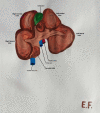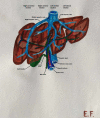Comparative Anatomical Study Between the Human and Swine Liver and Its Importance in Xenotransplantation
- PMID: 32864240
- PMCID: PMC7449635
- DOI: 10.7759/cureus.9411
Comparative Anatomical Study Between the Human and Swine Liver and Its Importance in Xenotransplantation
Abstract
The liver is a multifunctional organ; due to its functional and structural complexity, there are many factors that may lead it to function inadequately, a state called liver failure. Transplantation is the only appropriate therapy for patients in cases of liver failure. However, there are many limitations to this treatment, and the scientific community has considered methods based on pigs because of their unique structural and cellular compatibility with humans. In this review, we conducted an anatomic comparative study of the liver's parenchyma and vascular network between humans and pigs to extract useful information for xenotransplantation and autologous cell or organ generation in pigs. We reviewed articles from 2007 to 2019 and used the databases of Scopus, PubMed and Google Scholar. We concluded that, despite the difference concerning the shape of the human and pig livers, the number of segments and the bile and vascular system are similar, making the pig liver useful in experimental surgery for xenotransplantation.
Keywords: comparative anatomy; human; liver; pig; xenotransplantation.
Copyright © 2020, Ntonas et al.
Conflict of interest statement
The authors have declared that no competing interests exist.
Figures
References
-
- Coagulopathy in liver disease: a balancing act. Kujovich J. Hematology Am Soc Hematol Educ Program. 2015;2015:243–249. - PubMed
-
- Liver: metabolic functions. Campbell I. Anaesth Intensive Care Med. 2006;7:51–54.
-
- Immune responses in the liver. Kubes P, Jenne C. Annu Rev Immunol. 2018;36:247–277. - PubMed
-
- Complications and treatment of acute liver failure: current aspects. Mani I, Dourakis SP. https://www.mednet.gr/archives/2019-4/452abs.html Arch Hellen Med. 2019;37:452–463.
-
- Current concepts in acute liver failure. Rovegno M, Vera M, Ruiz A, Benítez C. Ann Hepatol. 2019;18:543–552. - PubMed
Publication types
LinkOut - more resources
Full Text Sources



